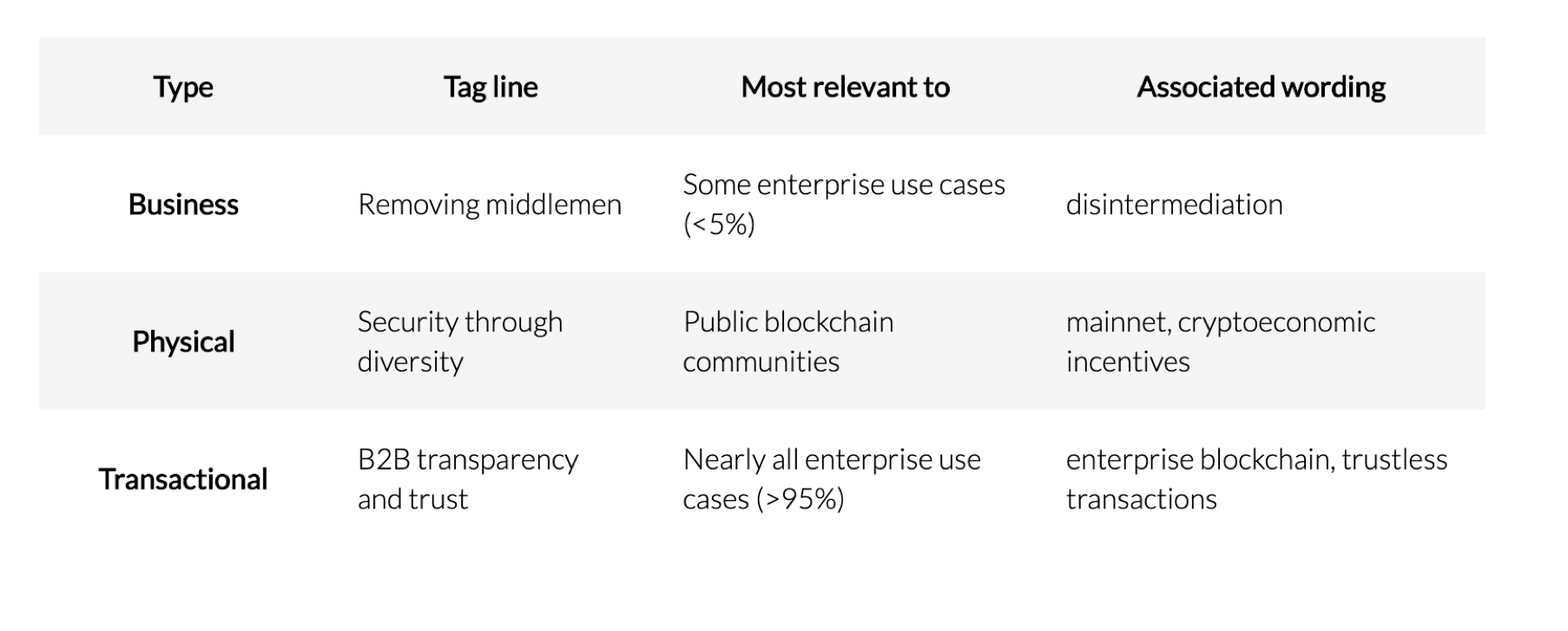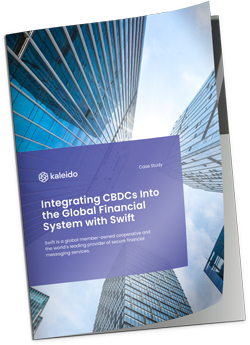

I’ve been working in the enterprise blockchain space since its earliest days in 2015 and there’s no topic I see more confusion about than that of Decentralization. Perhaps that’s because it appears to be a self-evident concept: in the IT space we all know what a centralized architecture looks like, and by inference, we also then assume we know what a decentralized architecture must look like. As a concept, however, decentralization is broader than IT architecture and even blurs across both technical and business domains.
I have learned that the true difficulty with decentralization is that there are actually three completely different definitions of it just within the blockchain space—and nearly everyone is unaware of this, so they are often jumbled together. It’s worth noting that all three definitions are perfectly valid in their own context. We’ve repeated our cardinal sin in IT: overloading a term with multiple meanings. This time, however, instead of recycling a term from a prior era we’ve simultaneously mixed several distinct concepts together. Very confusing indeed!
The three definitions of decentralization are so different that they often give rise to what we can jokingly call the “talking heads on a panel problem” where several people in a single blockchain conversation can completely talk across each other. In other words, if two people are discussing a blockchain topic and each has a different definition of decentralization in her mind, then each person will likely come to a very different conclusion about the topic. These incredibly different definitions are the real reason for so much confusion on decentralization.
Let’s get the three definitions out on the table. I list them in order of popularity that I see them referenced in the enterprise space:

Business Decentralization is the use of blockchain to eliminate centralized, single party processors by having the involved parties transact directly through a smart contract. This speaks to the potential for blockchain technology to be used to eliminate an existing central party “in the middle” holding all of the assets or data.

In the business definition we often hear about disintermediation: two parties which used to rely on a middle party to facilitate a transaction now transact directly with each other. Sometimes this business concept is also described pseudo-technically as transacting directly “point to point” and removing “extra hops”. In my experience, less than 5% of use cases businesses are actually working on would be in the category of business decentralization. Most of those middlemen exist for sound reasons or the journey to remove them is a long one.
Physical decentralization is the dispersion of runtime blockchain servers around the world being operated by as many different parties as possible.

The big idea here is something like “wouldn’t it be grand if we had a global technology infrastructure that no single party owned or controlled, and anyone could use if they can afford to”. For example, Bitcoin was designed to be censor-resistant—if you have a bitcoin then no one can stop you from spending it on the bitcoin network (assuming you have internet access to it). For mainnets, it is therefore essential to have a large, diverse group of users (often strangers) running the nodes of the network. These strangers are incentivized to do this because they are paid to run your transaction (technically the process is called “mining” and they often must compete to win the token prize by creating the best block of transactions).
Running a single, global network of blockchain servers (“mainnet”) is a big undertaking, especially if you want the network to be independent and self-sustaining. Broad, physical decentralization is a must for public blockchain mainnets but comparatively less significant for a private blockchain.
Transactional decentralization is the use of blockchain for B2B transactions to achieve greater efficiency, transparency, and trust in B2B networks. As enterprises have adapted the technology of blockchain to better suit their needs, they’ve done something profoundly powerful. The B2B transaction, the lifeblood of many businesses, has been completely reinvented.

All of the value chains and ecosystems in our global economy are formed by complex and many-sided business relationships. The two building blocks of these relationships are contracts and ledgers. A blockchain network gives you a new model for a transaction which uniquely uses contracts and ledgers in a novel, secure, and robust way. Enterprise blockchain features a shared ledger that is an immutable store of transactions and a common smart contract executing the business logic in an efficient and trustless way. A consensus process for executing, verifying and recording keeps the separate parties in lockstep. Finally, a cryptographic consent mechanism tied to the verified identity of the relevant parties ensures trusted results.
Perhaps because I’ve worked in enterprise blockchain exclusively since 2015, I find a particular type of confusion to be by very common: enterprise people assuming blockchain is all about business and/or physical decentralization and completely unaware of the true value of enterprise blockchain: transactional decentralization.
With this new technology paradigm, the B2B interaction is now incredibly streamlined: the parties execute the same exact contract, agree to the results once, and record the results in a choreographed fashion guaranteed to stay in sync. None of this is true in the B2B world today. And best of all, you haven’t sacrificed the things you care about most: your business does not give up any security, autonomy or control throughout this transaction process because the overall transaction is still decentralized.
Business, physical, and transactional decentralization are all valid concepts that form pillars of the larger blockchain ecosystem. They are, however, quite distinct. It is important to understand each of them in turn and the value they offer. Transactional Decentralization is the “unsung hero” of the space and it’s time for the enterprise community to realize its full potential.
There is a tremendous amount of business cost and value “trapped” in our ancient and inefficient Business Networks. Enterprise blockchain is the key technology to unlocking it by enabling B2B networks to be rebuilt on a modern collaboration plane. It allows these networks to benefit from enhanced coordination and transparency while transacting. However, since the transaction itself is decentralized, it gives businesses the assurance that they are still in control of their own transactions and data. While it has been to date lost amongst other types of decentralization, transactional decentralization is a game-changing construct in the toolbelt of CIO’s and Line of Business owners.
If you'd like to see decentralization within the context of a multi-party business network on a permissioned blockchain, you've got no further to look than Kaleido's Free Starter Account. Check out our full-stack blockchain platform for free, today. Sign up here!
Open a free account and connect with a Kaleido rep about how to control decentralization.
Try It FreeOpen a free account and connect with a Kaleido rep about how to control decentralization.
Try It Free


Open a free account and connect with a Kaleido rep about how to control decentralization.
Try It FreeOpen a free account and connect with a Kaleido rep about how to control decentralization.
Try It Free
Your guide to everything from asset tokenization to zero knowledge proofs
Download Now
Learn how Swift, the world’s leading provider of secure financial messaging services, utilizes Kaleido in its CBDC Sandbox project.
Download Now

